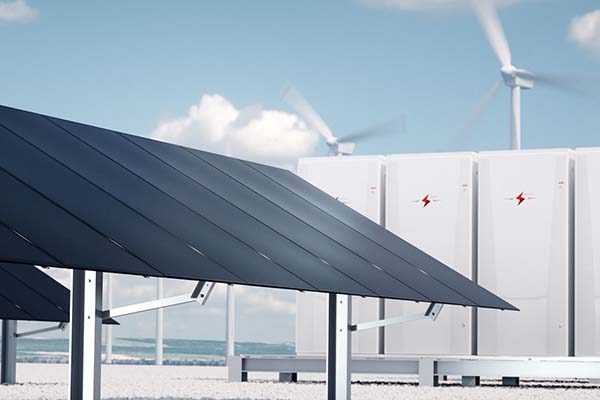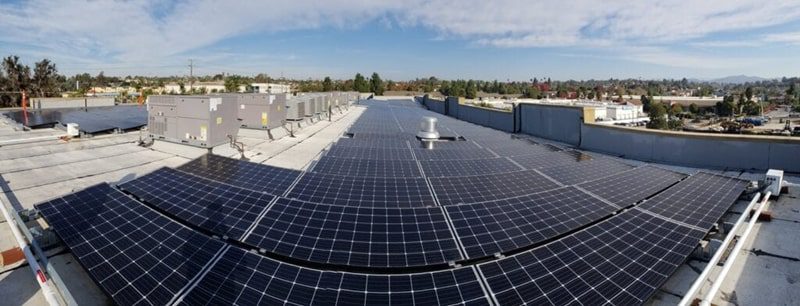If you’re thinking about building or upgrading a property and integrating solar power, your project may be a good candidate for Zero Net Energy (ZNE). The key difference between simply integrating renewable energy devices into your building and constructing a ZNE building is the careful design of all aspects of your building to significantly reduce your energy demand.
The Department of Energy defines a ZNE building as one that produces as much energy through renewable sources as it uses over the course of a specified time period. This is an ambitious goal for any building, but with advances in solar photovoltaics and building efficiency, it is becoming more attainable all the time. There are two components that come together to make a building or project net zero: renewable energy production, often in the form of solar panels, and energy efficiency measures, which reduce the demand for power. This “meet in the middle” approach is flexible, and allows for many new buildings and retrofitted buildings in a variety of settings and climates to attain Zero Net Energy status.
“Zero Net Energy building projects can often be less expensive in both the short and long term, than simply maximizing energy production with as many panels as possible.”
By reducing a building’s total energy load using a variety of energy efficiency measures including EnergyStar appliances, building envelope and insulation improvements, and efficient HVAC and architectural design strategies, less energy overall is required to run the building. Flattening the load profile and peak demand for a building reduces the amount of energy a building needs to operate. By reducing the amount of energy required to keep a building running, you can reduce the amount of solar generation needed to meet net demand. In practice, this means that ZNE projects can often be less expensive in the short and long term, than simply maximizing energy production with as many panels as possible.
What are the benefits of a Zero Net Energy Building?
Choosing to build and maintain a ZNE building encompasses all of the standard benefits of adding solar power to your building, but goes even further. As with solar energy production, a Zero Net Energy building will reduce energy costs and help mitigate climate change by reducing the carbon footprint of the building. By constructing a more energy-efficient building and reducing overall energy demand, your energy bill, even without solar generation, would go down significantly. Furthermore, since ZNE buildings typically put an emphasis on heating and cooling efficiency, they tend to be more comfortable for building occupants in the summer or winter without the need for excessive energy consumption on things like window A/C units or space heaters.
Zero Net Energy = Zero Net Emissions
With the addition of renewable energy generation, a ZNE building’s annual energy costs become negligible, and since there is a net-zero balance of energy production and use, your building’s carbon footprint with respect to energy consumption would also approach zero. There are plenty of factors that go into accounting for a carbon footprint, but energy is typically a leading source of emissions, so having a Net Zero Energy building can go a long way towards making your organization carbon neutral. Employees and other building occupants can feel good about their reduced reliance on fossil fuel-based energy without having to sacrifice the comfort of an appropriate lighting and ambient workplace temperature.
Ultimately, your organization needs to make decisions that benefit the financial bottom line, and Zero Net Energy can be a great way to mitigate future energy costs. Choosing to build for Zero Net Energy can seem more expensive up front, but depending on conditions like climate and available space for solar, Zero Net Energy can be done for little or no additional cost. Consider a comparable up front construction cost, but once the building is done, the ongoing cost for energy is nearly zero. If properly commissioned and planned, a Zero Net Energy building can make for a massive cost savings over the lifetime of the building. Many organizations assume that they cannot afford to build Zero Net Energy facilities because of historical precedents, climatic conditions, or space issues. But every day, ZNE buildings are planned and constructed for the same cost as regular buildings, and many more are built for a relatively small upfront premium, which is easily paid back through utility cost savings in a matter of months or years.
Zero Net Energy: Hitting the Target
Realizing a Zero Net Energy building is a complicated undertaking and requires a comprehensive understanding of the heating and cooling, lighting, and other energy requirements of a building. By using energy analysis tools and the expectations of the building’s future occupants, designers decide which efficiency methods are best, and pair them with an appropriate solar energy production plan. Whether a project employs radiant heating and cooling, a heat exchange system, efficient window design, or more efficient landscaping, it will need a very accurate estimate of the energy budget.
Once building designers have a good estimate of how much energy will be required to power the building throughout the year, the next step is determining how to produce sufficient solar power to meet the demand. The availability of space on the building roof or around the building is a key determinant in how a solar energy system is designed. There is a balance to be struck between building more solar power generation and spending more upfront to reduce the overall energy demand. This balance is specific to the energy needs, climate, and space available for solar generation of a given project. If there is relatively less space for solar panels, a building will need to go further in terms of reducing its energy demand, perhaps by including a greater investment in insulation, changing the location or size of windows, or by introducing another efficiency system, such as optimized daylighting or architectural design.
The National Renewable Energy Laboratory has developed a classification system for different Net Zero Energy Building (NZEB) types, depending on where the source of the renewable energy is located. For the most part, if the energy is generated within the building footprint, or on the same site as the building, it is given a better rating (NZEB:A or NZEB:B) as opposed to a building that imports or purchases its renewable energy from a remote location or through Renewable Energy Credits (NZEB:C or NZEB:D). Preference is given to buildings which can meet their energy needs within the footprint or on-site, as opposed to the alternatives.
What types of buildings are good candidates for Zero Net Energy?
Some of the best candidates for ZNE are buildings we all use day in and day out. Places like institutional, municipal or government buildings, schools and college buildings, commercial real estate, office buildings, and retail locations can all be ZNE if planned and constructed properly. Even some light manufacturing facilities have been retrofitted to achieve ZNE.
“When a municipal, government, or educational building strives for Zero Net Energy, it becomes a public and positive example of the impact on environmental and social good we can aim towards as a society.”
There are also examples of Zero Net Energy athletics facilities at the college and professional levels. Public buildings are great candidates since they are highly visible and are often imbued with a sense of collective ownership. For example, the Department of Energy is supporting Zero Net Energy in Public Schools and has seen an excellent response. When a municipal, governmental, or educational building strives for the designation, it becomes a public and positive example of the impact on environmental and social good we can aim towards as a society. Besides the obvious cost savings of a ZNE building, there is a tremendous boost in public perception when an organization sets itself as an example of what excellent engineering and planning, thoughtful investment, and intention can produce.
Is Zero Net Energy right for my project?
One common misconception is that the projects are just for the wealthy or environmentalist crowds, or that it is not plausible for a given set of space or climate conditions. The fact of the matter is that ZNE has been accomplished in every U.S. climate zone, and with the right investment and planning, any new construction and most retrofits can become ZNE. Get started by contacting a trusted renewable energy engineering firm like Veregy to determine what it takes for your project to be Zero Net Energy. Photovoltaic solar panels are continuously becoming more affordable and efficient, and with innovations across the board in HVAC, lighting, and design efficiency, Zero Net Energy has never been more accessible for institutional, industrial, commercial, and residential projects.
What happens at night or when it is cloudy?
It is important to understand that Zero Net Energy does not mean your building is running on the power it generates 24 hours a day. During night time or other times when solar generation is not sufficient, a ZNE building draws energy from the grid. Similarly, when more energy than is required is produced through solar generation, this excess flows back into the grid. Over the course of a specified time period, typically a year, a ZNE building will contribute as much or more energy to the grid as it draws from it.
Is my ZNE building “off-grid”?
ZNE buildings are not typically “off-grid”. In almost all cases they are grid connected and depend on energy from the grid to cover shortfalls in solar production when necessary. Power which is drawn from the grid must be equal or less than power contributed to the grid over a specified time period for a building to be considered Zero Net Energy.
Your Zero Net Energy Design
Whether you are trying to maximize your building’s efficiency, improve your bottom line, or reinforce your sustainability bona fides, a Zero Net Energy building design is a great option for both new builds and renovations. It means on average, your building is producing as much energy through renewable sources as it uses. Solar panels are the most popular option for power generation, and when deployed alongside the best building efficiency measures, Net Zero Energy is a surprisingly attainable goal.
Eliminating your energy footprint often translates to hugely reducing your carbon footprint, which is good for the planet as well as your overhead costs. Each Zero Net Energy project must be designed for the various specifications and conditions of the building. This means you will need experienced designers who are on the cutting edge of solar and building efficiency technology.
Veregy has over decades of experience developing and commissioning over 100MW of solar projects and will work with you every step of the way. Municipal, institutional, and education clients are among some of the most successful adopters of ZNE buildings, but there are also plenty of well-executed commercial ZNE projects as well. Get in contact with us and take the first step towards Zero Net Energy today.









